HIGHLIGHTS
PROGRAM UPDATES
Think Wood Coordinates, Delivers Effective Presence at 2019 AIA Conference Think Wood to Sponsor, Headline Tall Timber Building Track at CTBUH 10th World Congress AWC, Other Wood-Friendly Proposals Recommended for ICC 2021 Standards Approval Learning Lounge Puts WoodWorks in Spotlight at AIA ConferenceINDUSTRY NEWS
Google Parent Company Puts Mass Timber at Center of Urban Design Tall Wood Buildings Poised to Become a Climate Solution Federal Government Implements New Timber Use Standards for RUS Borrowers AIA Indexes Indicate Moderating Growth in Non-residential Construction Metrostudy to Provide 2019 Q3 Housing Forecast Update Massachusetts to Revise Building Code Based on 2021 IBC AIA Passes Resolution for Urgent, Sustained Climate Action LEVER Architecture Re-envisions Conservation Nonprofit’s HQ in Oregon New San Francisco Restaurant Uses Reclaimed Wood to Complete Design Wood Offers Inherent Advantages in Neutralizing Embodied CarbonINSIGHTS ON THE COMPETITION
Concrete Consumers Reluctant to Pay More for Greener AlternativesProgram Updates
Think Wood Coordinates, Delivers Effective Presence at 2019 AIA Conference
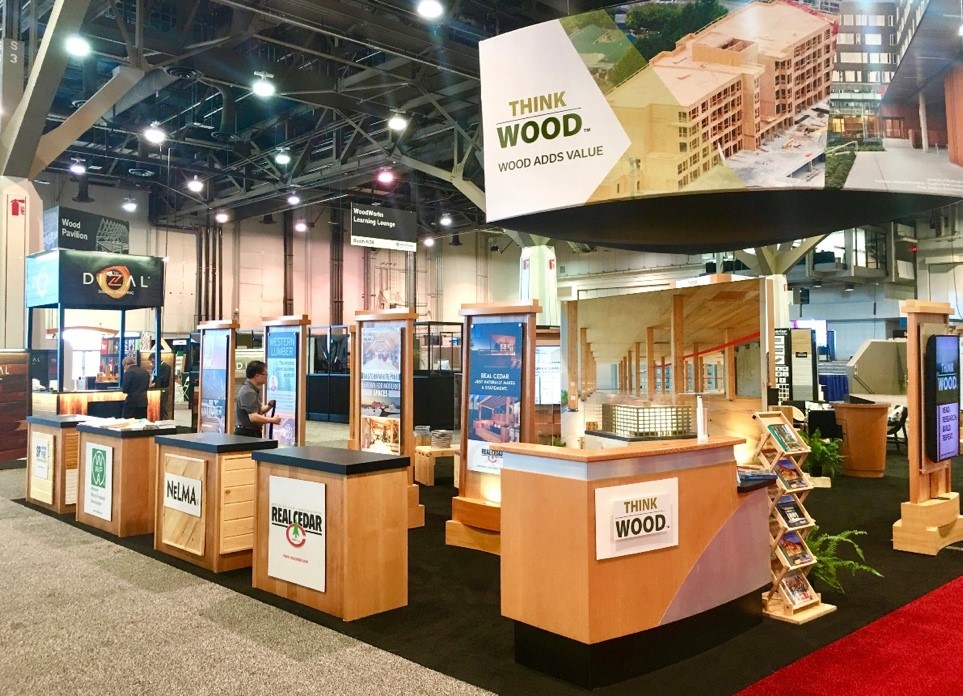
Think Wood once again anchored the softwood lumber industry’s presence at the American Institute of Architects (AIA) 2019 Conference on Architecture, held in June in Las Vegas, while leveraging and showcasing the expertise of partners like WoodWorks and a host of species associations such as WRCLA, NELMA, WWPA. This year’s booth featured video, product samples, literature, and new building models that brought to life upcoming code changes that will allow wood in taller buildings. Think Wood and partner staff connected with scores of architects, design professionals, and developers—representing firms as diverse as ARUP, SRB, Cooper Carry, the City of Seattle, Walt Disney Company, and the U.S. Army Corps of Engineers—on the latest developments in codes, continuing education, and wood products, as well as project-specific questions and ideas.
A third-party AIA evaluation found that Think Wood’s exhibit and presence ranked above 96% of the 200 other exhibitors in terms of effectiveness. One evaluator noted, “An attractive booth, strong use of audiovisuals . . . product and service presentation(s) did a good job of communicating brand promise and value proposition.”
Those staffing the booth noted an exciting shift away from participants questioning wood’s performance to a growing number who are already building with or actively considering wood for their projects.
Think Wood to Sponsor, Headline Tall Timber Building Track at CTBUH 10th World Congress
Think Wood has signed on to be a platinum-level lead sponsor of the Timber Rising program track at the upcoming Council on Tall Buildings and Urban Habitat’s (CTBUH’s) 10th World Congress, which will be held in Chicago from Oct. 28 to Nov. 2.
Timber Rising will be one of nine major program tracks at the conference. Over 1,500 delegates are expected to attend and together explore the inception, design, construction, and operation of tall buildings and future cities. Think Wood is collaborating with CTBUH to develop Timber Rising’s program, which will include two days of feature presentations and panel discussions as part of the core conference.
You can read more about the upcoming conference, including its impressive list of confirmed speakers, at: http://www.ctbuh.org/.
AWC, Other Wood-Friendly Proposals Recommended for ICC 2021 Standards Approval
The American Wood Council (AWC) was front and center during 11 days of International Code Council (ICC) Committee hearings, in which committee members reviewed and rendered recommendations on over 1,300 proposed Group B changes to ICC’s 2021 building standards.
Among the wood-friendly proposals, 19 of 21 submitted by the AWC and 19 of 24 submitted by others and supported by the AWC were recommended for approval. Meanwhile, the AWC’s expert testimony resulted in disapproval recommendations for 33 of 35 changes that would be detrimental to wood put forward by other industries.
Notable proposals include the following:
- Three proposals put forward by the ICC Tall Wood Ad Hoc Committee that address special inspections and connections for tall wood buildings were approved, while a competitor proposal seeking to require special inspections of mass timber construction was recommended for disapproval.
- A proposal that comprehensively updates AWC’s new standards referenced by ICC was recommended for approval.
- A competitor proposal calling for special inspections of light-frame wood construction for routine elements such as grade marks and nailed connections was recommended for disapproval.
An AWC proposal regarding the inspection of prefabricated building parts not visible on job sites was recommended for disapproval; however, as a result of the AWC’s effort, ICC created a new Off-Site and Modular Construction Standard Committee to develop standards to foster increased prefabrication construction.
The committee’s recommendations now move forward to final public comment hearings and a final vote by ICC’s membership this fall. Before the vote, the AWC will hold its annual technical committee meetings to bring wood industry professionals together to discuss the pending proposals and strategies to achieve favorable outcomes on behalf of the softwood lumber industry.
Learning Lounge Puts WoodWorks in Spotlight at AIA Conference
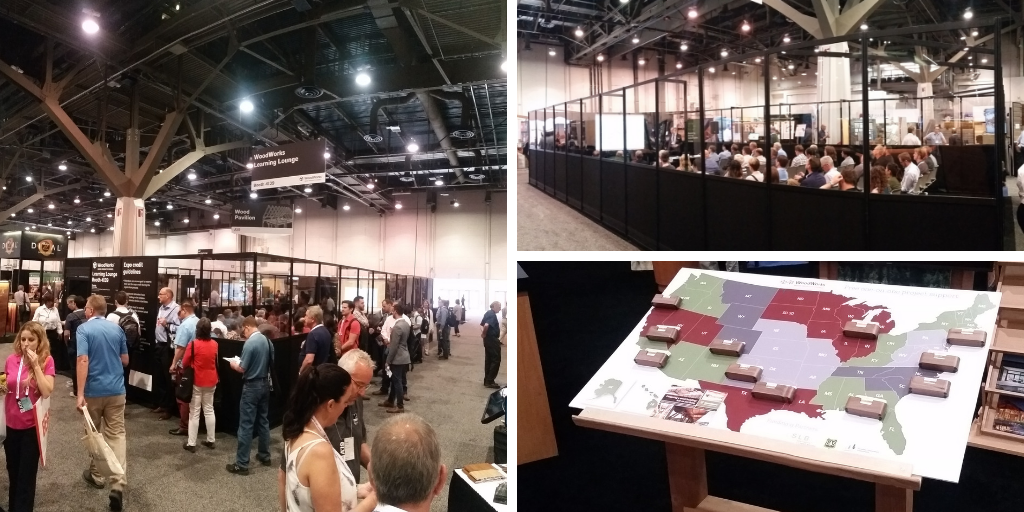
For the third year in a row, WoodWorks hosted its popular Learning Lounge at AIA’s annual Conference on Architecture, held in June. More than 400 building design professionals visited the lounge and listened on as WoodWorks staff presented sessions on tall wood code changes, mid-rise fire-resistance design and detailing, modular and off-site construction, and timber offices. Practicing architects added to the depth of content by presenting three unique case studies featuring wood. After the presentations, many attendees stopped by the wood industry’s booth, coordinated by Think Wood, to pick up materials and discuss projects with WoodWorks representatives.
The Learning Lounge continues to prove effective in attracting and introducing new architects to WoodWorks while demonstrating the expertise of WoodWorks’ technical and field staff—most of whom are engineers or architects themselves.
Industry News
Google Parent Company Puts Mass Timber at Center of Urban Design
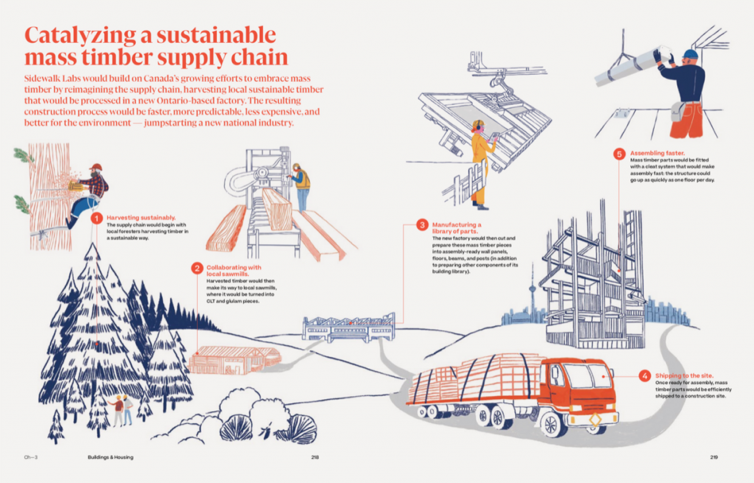
Sidewalk Labs, a subsidiary of Google parent company Alphabet Inc., recently revealed plans for Sidewalk Toronto, a transformational development plan for the 12-acre Quayside area on Toronto’s eastern waterfront. Sidewalk Labs envisions turning Quayside into a global model for sustainable, inclusive, and inventive growth, with all structures—including ones as tall as 30 stories—built of mass timber. Skywalk Labs is deliberately prioritizing mass timber thanks to its cost-efficiency in production and assembly, asserting that mass timber can help Quayside to meet its ambitious affordable housing goals while still meeting its equally ambitious sustainability goals. The master plan goes so far as to propose the creation and capitalization of a mass timber factory close to Toronto to jump-start the industry and meet demand. Mass timber pioneer Michael Green Architecture was among those consulting on and lending expertise to the project.
The proposal comes nearly two years after Sidewalk Labs won the mandate to build the community with Waterfront Toronto, a public corporation created to revitalize formerly industrial land along Lake Ontario. The total investment is estimated at $980 million. Sidewalk Toronto will soon enter a public comment period, while the development team continues to work with the Canadian government to gain approval.
Tall Wood Buildings Poised to Become a Climate Solution
Grist, a nonprofit e-magazine covering energy and environment, recently explored how cross laminated timber (CLT) and tall wood buildings can together create a climate solution. In its video primer, Grist notes how tall wood buildings are slowly but steadily gaining traction in the United States, following the lead of Europe and, more recently, Canada.
Grist notes that while timber production requires sound and diligent management, especially for timber sourced from some international markets, CLT used in tall buildings, if done right, the buildings themselves could be a climate solution.
Watch Grist’s video here.
Federal Government Implements New Timber Use Standards for RUS Borrowers
The Rural Utilities Service (RUS), an agency of the U.S. Department of Agriculture, recently updated its bulletins that outline construction standards and specifications for wood utility poles, anchor logs, solid and laminate wood crossarms, and pole keys. These bulletins apply to systems constructed by electric and telecommunications companies that borrow federal funds.
Many changes are administrative in nature, and nearly all are intended to keep RUS standards current with technology advances and consistent with industry best practice. Manufacturers of structural glued laminated timber using southern pine, coastal region Douglas fir, Hem fir, and other species of similar treatability for electric power and communication structures are most likely to be affected.
RUS is accepting comments on changes until August 2, here.
AIA Indexes Indicate Moderating Growth in Non-residential Construction
The AIA’s Architecture Billings Index (ABI) score, which tracks demand for design services, was 50.2 in May, down slightly from 50.5 in April. The ABI is a leading, monthly economic indicator to assess business conditions and predict and track the non-residential construction market. Any score above 50 indicates an increase in billings. AIA’s project inquiries and design contracts indexes also softened in May but remained positive at 56.2 and 50.9, respectively.
May marks the fourth consecutive month that billings have been flat or decreased. AIA Chief Economist, Kermit Baker, notes that this is “the longest period of…sustained softness since 2012.” Coupled with the softening of new project inquiries and the value of new design contracts, Baker believes that this may be “another sign that the amount of pending work in the pipeline at firms may be starting to stabilize.”
Metrostudy to Provide 2019 Q3 Housing Forecast Update
Mark your calendar for the upcoming Metrostudy 3Q19 Quarterly Housing Forecast Webcast, which will be held on Tuesday, Aug. 13, from 2 to 3 p.m. EST / 1-2 p.m. CST. Metrostudy is a leading provider of market information for the housing and residential construction industries. Its Q3 webcast will include an update on the current state of the U.S. housing market and offer an in-depth look at markets in the Rocky Mountain and Desert metro areas.
Click here to register and/or send your questions, comments, and feedback to: hknutson@metrostudy.com.
Massachusetts to Revise Building Code Based on 2021 IBC
Massachusetts’ Office of Public Safety & Inspections recently announced that it will develop the state’s 10th edition building code using the 2021 International Codes as a template, with an effective date of Jan. 1, 2021. Previously, the state had intended to use the 2018 International Codes as the basis for its 10th edition. This shift will enable Massachusetts’ revised code to reflect forthcoming changes allowing the expanded use of mass timber, as included in the IBC 2021.
Read more here.
AIA Passes Resolution for Urgent, Sustained Climate Action

At the recent annual AIA Conference on Architecture, the architecture and building community voted overwhelming in favor of an AIA Resolution for Urgent and Sustained Climate Action as a critical health, safety, and welfare issue; the final vote was 4,860 yes to 312 no.
The resolution calls for AIA’s 94,000 members worldwide to “exponentially accelerate the decarbonization of buildings, the building sector, and the built environment.” The resolution also calls for a multiyear strategy for education, practice, advocacy, and outreach targeting its membership, clients, policymakers, governing bodies, and the public in order to build support for climate action and the acceptance of zero-net-carbon buildings as standard practice.
Read the full resolution here.
LEVER Architecture Re-envisions Conservation Nonprofit’s HQ in Oregon
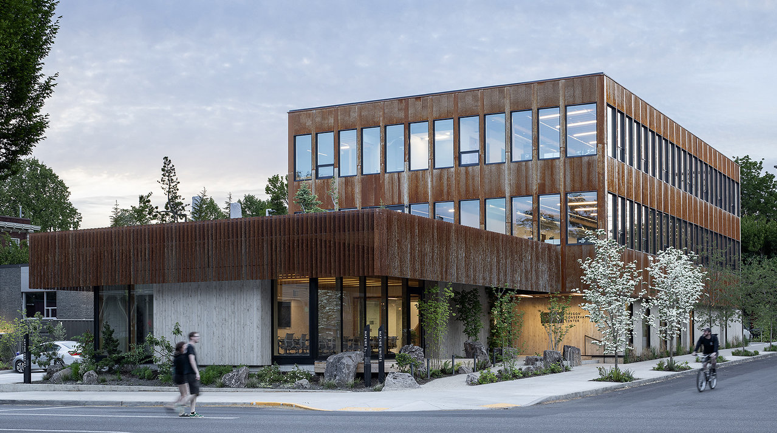
The Nature Conservancy (TNC) recently celebrated the opening of the Oregon Conservation Center in Portland, Ore., its 15,000-square-foot state headquarters that was recently re-envisioned by Portland-based LEVER Architecture.
LEVER was intentional in designing and renovating the space to better reflect TNC’s mission of environmental conservation. LEVER’s design integrates softwood lumber and other natural materials and plantings reminiscent of TNC’s conservation work across Oregon. The building’s exterior includes sustainably harvested juniper siding and cedar decking.
Read more about TNC’s new building here.
New San Francisco Restaurant Uses Reclaimed Wood to Complete Design
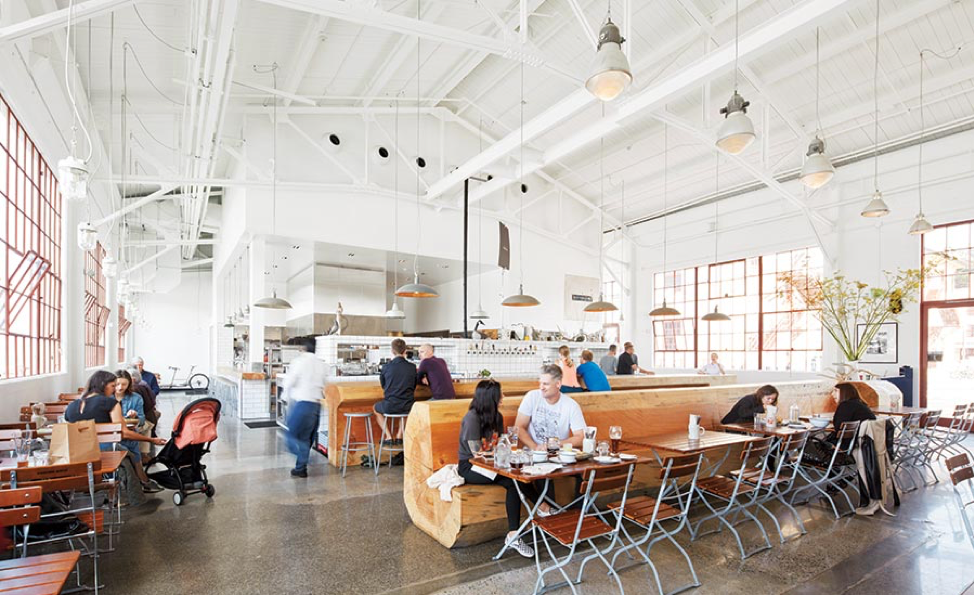
Architectural Record recently profiled Radhaus, a new beer hall designed by Berkeley-based architecture firm, Envelop A+D, which occupies one of several landmark buildings in a former military port in San Francisco. The 125-seat, 1,350-square-foot eatery occupies an old warehouse built using steel trusses and concrete blocks and offers expansive views of the Golden Gate Bridge and a marina. The Envelop A+D team relied on wood to add warmth to the interior, using two salvaged 300-year-old Ponderosa pines to create a 30-foot-long bar and a large bench that provides communal seating.
Read more here.
Wood Offers Inherent Advantages in Neutralizing Embodied Carbon
Architect Magazine’s A+ Session series recently explored the role design plays in reducing negative effects during construction in an interview with Carl Elefante, 2018 AIA President, principal at Quinn Evans Architects, and a nationally recognized expert on sustainability.
Elefante notes that, to truly assess impact, architects need to consider the individual footprints of each material used in their project and weigh this information when specifying. Elefante cites wood as having inherent carbon advantages compared with other materials due to its sequestration ability—as long as the wood exists, its carbon is stored. This is in contrast with concrete, for example, which requires considerable energy in its production and literally releases carbon in the process.
View the full excerpt of Elefante’s interview here.
Insights on the Competition
Concrete Consumers Reluctant to Pay More for Greener Alternatives
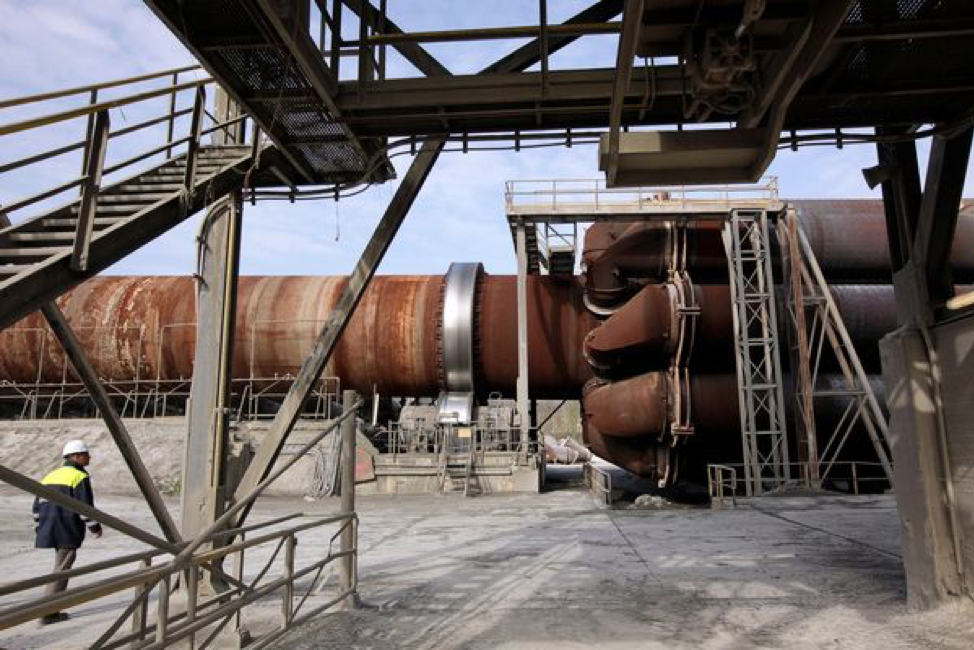
Bloomberg recently iterated statistics from the International Energy Agency’s World Energy Outlook 2018 that show the cement industry is responsible for 7% of global carbon dioxide (CO2) emissions or more than what is produced by all the trucks in the world.
According to the European Cement Association, one ton of cement yields at least one-half of a ton of CO2, which is more than the average car produces when driving from New York to Miami. A single mixer truck can carry about 13 tons of cement, while a typical office building contains hundreds to even thousands of tons of cement.
Bloomberg points out that, despite these enormous emissions, leading cement makers, including LafargeHolcim in Switzerland and Votorantim Cimentos in Brazil, are finding that their customers are reluctant to adopt the cleaner and greener alternatives they are developing, largely because of price. According to Jens Diebold, LafargeHolcim’s head of sustainable development, “There is so far too little demand for sustainable materials…I would love to see more demand from customers for it.”
You can read Bloomberg’s full piece here.
Industry Resources
FEA Housing Dashboard
Virginia Tech’s Monthly Housing Report
This monthly housing commentary report is a free service of Virginia Tech and is intended to help one gauge future business activity in the U.S. housing market.
May 2019 Reports (released in June 2019)
Part A: May Housing Commentary
Part B: May Economic Conditions

